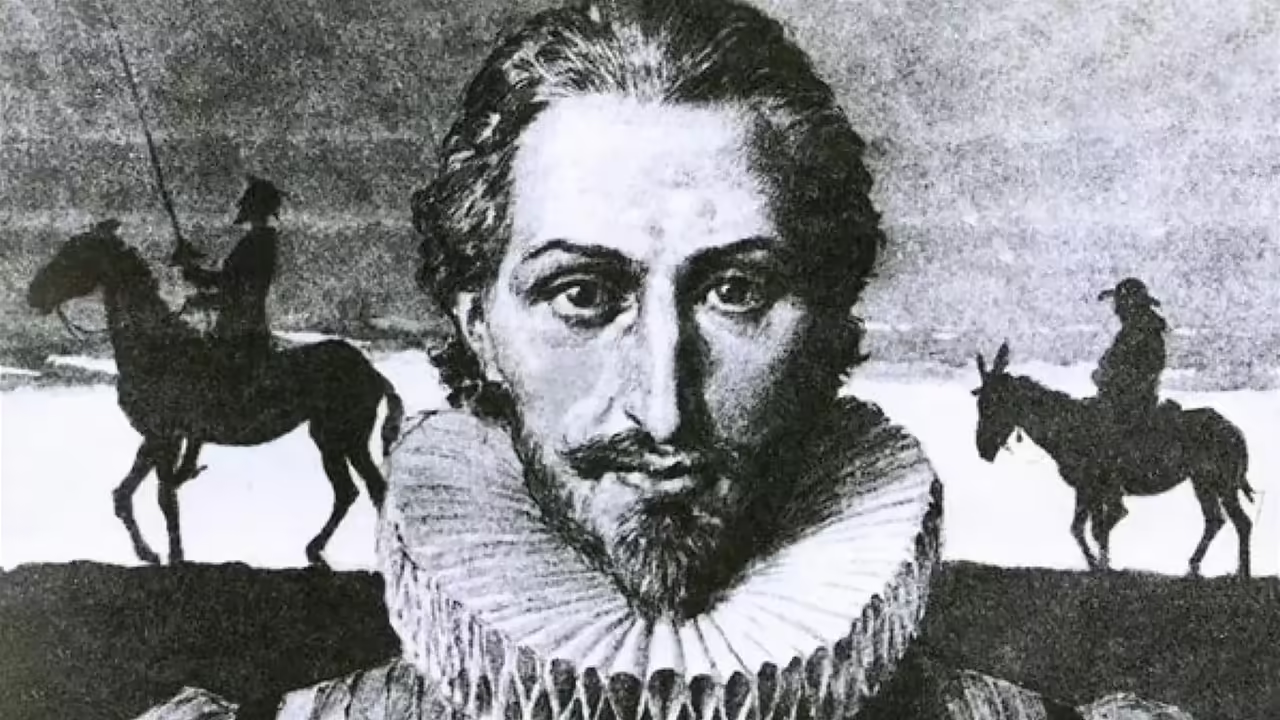
Miguel de Cervantes was a soldier, novelist, poet and playwright born in Spain, specifically in the city of Alcalá de Henares, on September 29, 1547, and died on April 22, 1616.
His contributions as a soldier are null, however, in the literary field he is important.
In fact, he is considered to be the greatest disseminator of the Spanish language; in fact, the Spanish language itself, or Castilian, is also known as the language of Cervantes.
Cervantes began his literary career at the age of 30 and published his first work, “La Galatea”, in 1585. However, it is his most famous work, “Don Quixote”, published in two parts in 1605 and 1615, that made him famous worldwide. “Don Quixote” follows the adventures of the knight Don Quixote de la Mancha and his squire Sancho Panza in their struggle against windmills and other imaginary enemies. The work is known for its witty irony and its criticism of chivalry and the society of the time.
In addition to “Don Quixote,” Cervantes also wrote a number of plays, including “The Labors of Persiles and Sigismunda,” “La Numancia” and “The Siege of Numantia.” He also wrote numerous short stories and tales, such as those contained in his book “Novelas ejemplares”.
Despite his literary success, Cervantes spent much of his life struggling with poverty. During his life, he worked as a soldier, cab driver and scribe, and was imprisoned several times for debts and other financial problems. However, his dedication to literature never waned and he continued to write until his death in 1616.
Cervantes’ legacy remains strong to this day. “Don Quixote” has been translated into more than 50 languages and has been the subject of countless theatrical, film and musical adaptations. Furthermore, the figure of Don Quixote has become a cultural symbol around the world, representing bravery, nobility and madness.
In addition to his impact on literature, Cervantes also had a significant impact on popular culture and society in general. Many of the characters and situations that appear in his works have been incorporated into everyday language and popular culture, and have been the subject of imitation and parody on countless occasions.
Cervantes was also noted for his ability to combine elements of comedy and tragedy in his works, and for his ability to create complex and memorable characters. For example, Don Quixote is both a hero and a madman, and his interaction with Sancho Panza provides a perfect balance between seriousness and humor.
In addition, Cervantes was also noted for his ability to address universal themes in his works, such as truth, justice, freedom and love. These themes remain relevant in today’s society and continue to inspire writers and artists around the world.
It is also important to highlight Cervantes’ role in the evolution of the novel as a literary genre. With “Don Quixote,” Cervantes laid the groundwork for the modern novel and established many of the elements that are considered characteristic of the form, such as the inclusion of a complex plot, detailed characters and a fluid narrative.
Another aspect worth noting is Cervantes’ impact on European literature. His works were translated and admired throughout Europe and had a significant impact on French, German and English literature, and his ideas and literary techniques were imitated by many writers throughout the continent.
A precursor of the Spanish language
Cervantes also had a significant impact on linguistics and the development of Spanish as a language. As a writer at a time when Spanish was still evolving, Cervantes helped establish the standard and style of the Spanish language and set many of the words and phrases used today.
One of Cervantes’ most important contributions to the Spanish language was his innovative use of language. In his works, Cervantes used simple and direct language that was easy for the public to understand, which allowed him to reach a wider and more diverse audience. In addition, he used a wide variety of turns of phrase and expressions that became part of everyday language and have been incorporated into the Spanish language to this day.
Another important contribution of Cervantes to Spanish was his use of irony and humor. In his works, Cervantes used these resources in a masterful way to criticize the society of his time and to make his readers reflect on important issues. These elements became a distinctive feature of Spanish literature and have been incorporated into the writing of many other authors over the years.
Cervantes also made important contributions to the development of Spanish prose. In his works, he used an innovative writing style that became a model for many later writers. He was also one of the first writers to use a more complex and structured style of narration, which included the incorporation of several narrators and a wide variety of literary genres.
The life of Cervantes
Regarding the life of Miguel de Cervantes, it is important to note that he was born in Alcalá de Henares, Spain in 1547. He was the son of a poor surgeon and had a busy childhood, traveling all over Spain and America during his youth. This allowed him to acquire a broad culture and knowledge of the world, which he would later reflect in his works.
Despite his success as a writer, Cervantes’ life was marked by poverty and hardship. He spent much of his life struggling to survive and support his family, and on several occasions he was on the verge of destitution. However, his love of literature and his determination kept him on his path to the end.
Cervantes died in Madrid in 1616 and was buried in the church of the Trinitarios, where his tomb remains a place of pilgrimage for admirers of his work.
Language Day
Language Day is a celebration that takes place on April 23 in Spain and other Spanish-speaking countries. It commemorates the birth of Miguel de Cervantes.
Language Day is an opportunity to celebrate the richness and diversity of the Spanish language and to reflect on its importance in the culture and identity of Spanish-speaking countries. On this date, cultural activities and events are held, such as conferences, contests and activities for children, to commemorate the life and work of the writer and the legacy of his language.
Main works of Cervantes
In addition to “Don Quixote”, Cervantes wrote many other works, including “Exemplary Novels”. These twelve short stories span a wide range of genres, including comedy, drama, and tragedy. Each of the exemplary novels offers a deep and thoughtful insight into life and humanity, and many of them are considered masterpieces of Spanish literature.
Another important work by Cervantes is “Voyage of Parnassus”. Written in verse, this work is a satire on the life of the poets and writers of his time. Through narrative, Cervantes offers a sharp critique of the society and culture of his time, and defends the importance of literature and poetry as means of reflection and social criticism.
Finally, “Eight comedies and eight new hors d’oeuvres never represented” is a collection of plays written by Cervantes. These plays combine humor, irony and deep reflection on life and humanity, and are considered important examples of 16th century Spanish theater.
Facts you didn’t know about Cervantes
Cervantes was born in Alcalá de Henares, Spain, in 1547, but he spent most of his life in Madrid.
Cervantes was a well-travelled man and held various professions throughout his life, including soldier, taxi driver, and public servant.
During his time as a soldier, Cervantes was captured by Barbary pirates and held as a slave for five years in Algiers.
Cervantes wrote several plays in his youth, but they were unsuccessful and are little known today.
Cervantes was a man of great literary ambitions, but had difficulty gaining recognition and fame during his lifetime.
Despite being the author of one of the most influential books in Western literature, “Don Quixote de la Mancha”, Cervantes died in relative poverty and without receiving proper recognition for his work.
There are several theories about Cervantes’ death, including the possibility that he died of an epidemic or an injury related to a street fight.
Despite being considered one of the most important writers in Spanish literature, Cervantes’ personal life remains a mystery. Not much is known about his childhood and youth, and some of the details of his life are the subject of speculation and controversy.
It is believed that Cervantes was a religious man and that his faith influenced his work. In “Don Quixote”, for example, various religious elements can be found, including the importance of faith and morality.
Cervantes’ death on April 22, 1616 coincides with the death of William Shakespeare, another great writer of the time. This has led some to refer to this date as the “End of the Golden Age of Literature”.
He was one of the first writers to use Castilian Spanish instead of Latin, and his work has been recognized for its fluid style and ability to capture human nature.
Aside from his work as a writer, Cervantes is also known for his service to the Spanish Crown. During his life, he worked as a civil servant in various positions, including the position of tax collector in Grenada and the position of customs agent in Lisbon.
Regardless of his success in literature, Cervantes’s life was marked by adversity. In addition to his captivity in Algiers, he also spent time in prison in Spain, probably due to financial problems.
Miguel de Cervantes was married to a woman named Catalina de Palacios Salazar y Vozmediano. However, little is known about her life and personality due to a lack of historical information.
Catalina and Cervantes are believed to have married in 1584, but the exact details of their wedding are uncertain. It is known that she was from a noble family and that she had a small fortune, which probably helped Cervantes to establish himself as a writer and to maintain his literary career.
Unfortunately, there are not many documents that address Catalina’s personal life, so it is difficult to know much about her personality or her relationship with Cervantes. However, it is believed that she supported her husband in his literary career and accompanied him on his travels through Spain.







